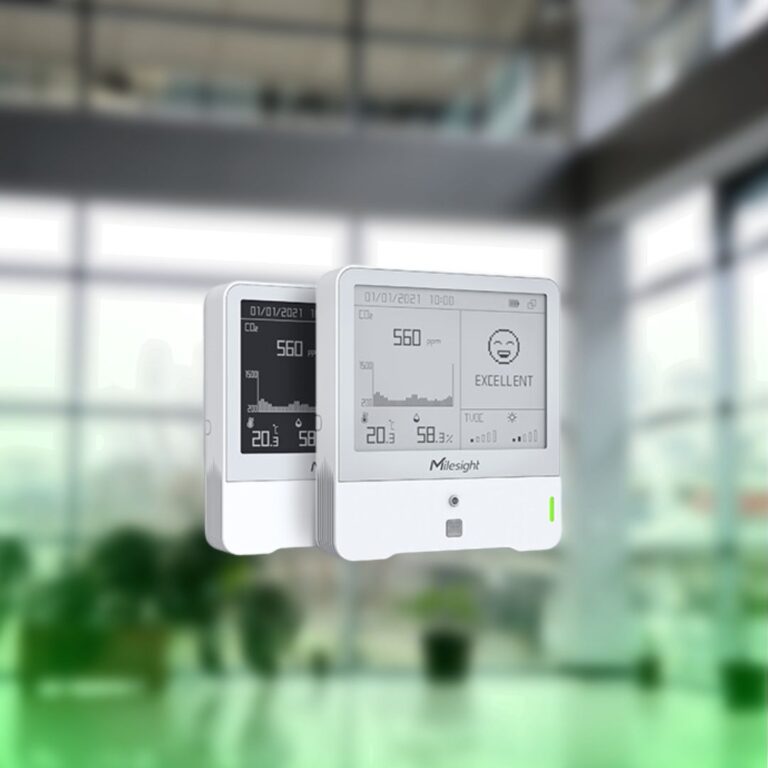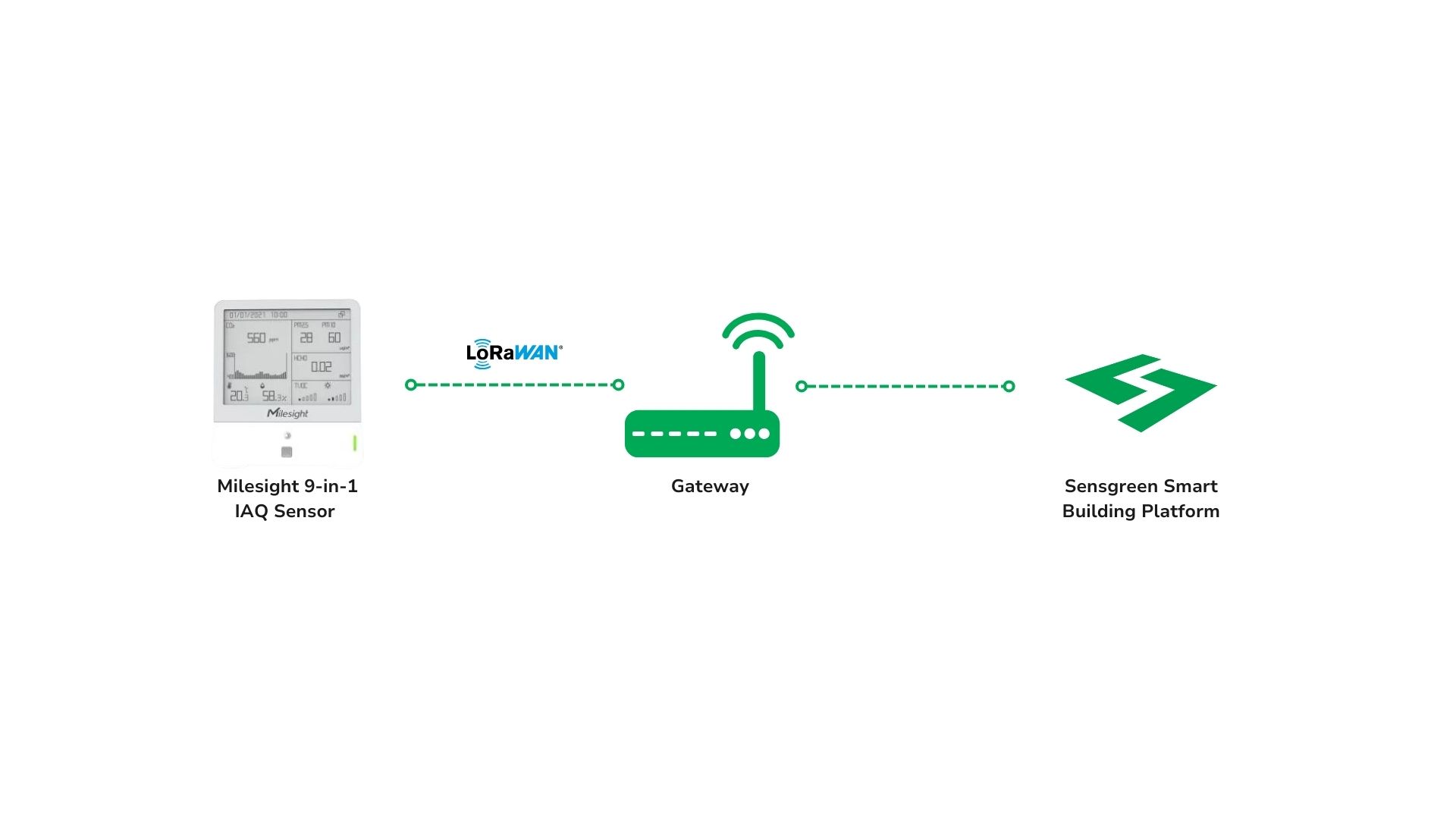Indoor Air Quality
Sensgreen Partner
Milesight
Location
Dubai
Applications
HVAC System Optimization, Indoor Air Quality Optimization, Improved Occupant Health and Productivity
Background
We frequently ignore indoor air quality in our hectic modern lives, despite the fact that it has a big impact on our health. Immediate irritation of the eyes, nose, and throat can be brought on by pollutants, and chronic illnesses or respiratory disorders may result from prolonged contact. To identify issues and respond quickly, indoor air quality (IAQ) monitoring must be done continuously. IoT sensors are essential to this endeavor since they provide proactive steps for a healthier indoor environment and provide real-time data on air quality metrics.

Challenges
Limited Visibility
Without IoT sensors, building occupants and facility managers lack real-time insight into indoor air quality. Relying on manual testing or occupant observations often results in inaccurate and untimely data about contaminants.
Absence of Data-Driven Insights
Traditional methods struggle to generate comprehensive data-driven insights, making it hard to identify patterns, trends, and correlations in air quality. This hinders pinpointing sources of problems and implementing targeted solutions.
Inefficient Resource Use
Without real-time data, HVAC systems may operate inefficiently, wasting energy and increasing costs. Lack of information on pollutant levels and occupancy patterns can lead to inadequate ventilation, affecting both air quality and energy efficiency.
Scaling Challenges
Managing indoor air quality in large buildings or complex HVAC systems is challenging without IoT sensors. Ensuring consistent air quality across vast areas manually is resource-intensive and less effective.
Solution
Particulate matter and volatile organic compounds (VOCs) are examples of indoor air pollutants that can harm productivity, cognitive function, and respiratory health. This success story demonstrates how IoT sensors can optimize HVAC system and indoor air quality (IAQ). Sensgreen and Milesight installed 50 Milesight AM319 IAQ sensors in five opulent Palm Jumeirah, Dubai, residences. These sensors continuously collected data on indoor conditions and HVAC performance by monitoring temperature, humidity, occupancy, CO2 levels, and particulate matter.

Integrating Milesight sensors with Sensgreen’s Smart Building platform led to notable enhancements in energy efficiency and quality of life. Predictive maintenance of AHUs lowered energy expenses by 12%, while smart modulation of VAV units cut energy usage by 16% during off-peak hours. Proper humidity levels were kept, which improved visitor comfort and preserved furniture. Alerts for predictive maintenance shortened the time it took to fix HVAC problems by 35%, extending the life and dependability of the system. This project establishes a new benchmark for upscale residential settings’ energy-efficient HVAC control.

”Sensgreen's collaboration in the prestigious Palm Jumeirah villas in Dubai has revolutionized HVAC management. The project integrates luxury with environmental sustainability by integrating Milesight IAQ sensors with the Sensgreen Smart Building Platform. This has set a new standard in energy efficiency and proactive maintenance while elevating the comfort and luxury of these high-end residences.
Facility Manager of The Villas
Results
HVAC Optimization Using Data Analysis
It generates information that facility managers regularly check to spot trends and abnormalities in HVAC performance. These reports contained data on humidity levels, temperature swings, and air quality indicators, all of which were essential for determining how well the current HVAC settings worked.
Intelligent Alerts for Quick Action
The system was enhanced using Sensgreen’s notification bot, which is programmed to instantly notify users via WhatsApp when there are notable variations in temperature, humidity, or air quality. The facility management staff was able to promptly resolve any environmental issues thanks to this quick notice system, guaranteeing a constantly safe and comfortable indoor atmosphere.
Optimal Humidity Management for Health and Comfort
Maintaining ideal indoor humidity levels is essential for comfort and health in Dubai’s arid climate. The facilities management team was able to execute efficient humidity control techniques with the help of the smart reports from the platform, which offered comprehensive insights into the humidity levels throughout the villas.
Faster Decision-Making
The crew adjusted the HVAC operations based on well-informed judgments made possible by the insights from Sensgreen’s reports. In order to assure effective energy consumption without sacrificing guest comfort, they used the data to establish ideal temperatures, pinpoint the best periods for heating or cooling, and make necessary adjustments to settings.
Maintenance That Is Predictive
The platform analysis assisted in forecasting maintenance requirements. For instance, it might be a sign that system maintenance or filter replacements are required if the reports consistently demonstrated a drop in air quality. By keeping the HVAC systems operating at maximum efficiency, this proactive maintenance strategy decreased the possibility of unplanned malfunctions and energy waste.
Optimization of Energy Use
Based on the IAQ data, the facilities management team was able to considerably minimize wasteful energy use by coordinating the HVAC operations with the real needs of the villas. The HVAC systems were able to be adjusted according to the data-driven strategy.

